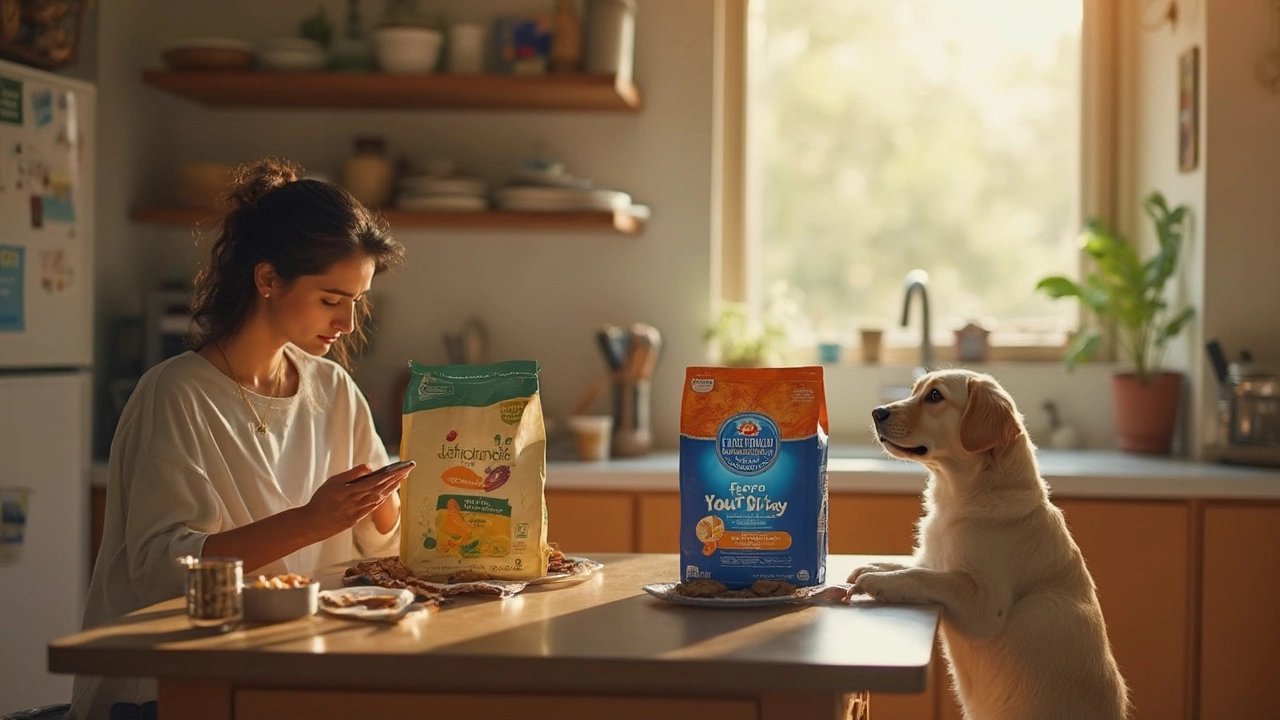
Ever stood in the pet food aisle racking your brain about Blue Buffalo or Purina? You're not alone. Picking the right dog food feels like rocket science sometimes when you want your dog to eat well but also not flip your budget upside down.
It's not just about flashy bags or fancy taglines—ingredients and your dog's health matter most. Some people swear by Blue Buffalo's 'natural' formulas, while Purina fans love the brand's long track record and vet support. But what does that really mean for your dog's bowl every day?
We're cutting through the jargon to look at what actually goes into each brand and how these choices might affect your furry friend. Expect clear info about ingredients, which recipes work best for sensitive pups, and what kind of surprises you want to avoid in pet food. If you're after tips that keep real dogs happy and healthy—not just marketing promises—you're in the right place.
- First Look: What’s in Blue Buffalo and Purina?
- Ingredient Quality and Nutrition
- Dog Health: The Real-World Impact
- Recalls and Safety Records
- What Vets and Owners Say
- Price, Availability, and Final Thoughts
First Look: What’s in Blue Buffalo and Purina?
Picking the right chow for your pup usually starts by flipping over the bag and eyeing that tiny ingredient list. Here’s the deal: both Blue Buffalo and Purina pack some popular recipes, but they approach the recipe game a little differently. Blue Buffalo talks big about ‘real meat first’ and points to natural ingredients. Purina has wider options, even some prescription diets your vet might recommend for health issues.
If you check a bag of Blue Buffalo Life Protection dry food, you’ll spot chicken as the first ingredient, followed by brown rice, barley, and a mix of veggies like peas and carrots. They also often toss in omega fatty acids for healthy coats, and something they call “LifeSource Bits”—a blend of vitamins and antioxidants baked separately. Blue Buffalo skips by-products and artificial flavors in most recipes.
Over at Purina, things depend on the line. Their Purina ONE and Pro Plan formulas usually start with some kind of meat (like chicken or salmon), but you’ll also spot by-product meals in many recipes—some dog owners mind, some don’t. They mix in rice, corn, and sometimes wheat for carbs. Preservatives and colorings show up in a few formulas (especially in Purina Dog Chow or Beneful), but their Pro Plan line is more ingredient-conscious.
Here’s a snack-sized look at their popular dry foods:
| Brand | Main Protein Source | Grain Type | Special Additions | Comment |
|---|---|---|---|---|
| Blue Buffalo Life Protection | Real Chicken | Brown Rice, Barley | LifeSource Bits, Omegas | No by-products or artificial flavors |
| Purina Pro Plan | Real Chicken (or Salmon) | Rice, Corn | Prebiotics, Omegas | Some formulas have by-product meal |
So, if your dog has sensitive digestion or you like knowing exactly what’s in their bowl, Blue Buffalo leans into transparency and limited ingredients. If you want choice (and maybe save a few bucks), Purina spreads out with a massive product lineup for different life stages and health needs. Both have grain-free and grain-inclusive options too, depending on what your vet recommends.
Bottom line? Always start by reading both ingredient lists. Don’t just trust the pretty bag. The differences between these brands set the tone for how the rest of your food hunt will go.
Ingredient Quality and Nutrition
Dog owners get a lot of buzzwords—"natural," "grain-free," "real meat first." But when you peek under the hood, what exactly are you feeding your dog with Blue Buffalo or Purina? Let’s break it down with specifics, because labels alone don’t tell the whole story.
Blue Buffalo really makes a big deal about using real meat as the first ingredient in their most popular recipes. You’ll typically see things like deboned chicken, fish, or lamb listed right up front. They also go big on fruits and veggies like blueberries, sweet potatoes, cranberries, and peas. Most Blue Buffalo lines avoid poultry by-product meals—which means no leftover feet, feathers, or beaks.
Pound-for-pound though, Blue Buffalo’s use of things like peas and potatoes has raised eyebrows with vets after some links to canine heart problems. Also, their "LifeSource Bits" (those dark nuggets) are packed with vitamins and antioxidants, but some dogs just spit them out.
Now, Purina's nutrition story looks a bit different. Take the Pro Plan line—a favorite for lots of breeders and professional trainers. Yes, chicken or salmon usually kicks off the ingredient list, but you’ll also spot things like rice, barley, and yes, meat by-products. You might think by-products are bad, but they can include organ meats dogs actually need and love. Purina’s big strength is their nutrition is put together by a bunch of actual pet nutritionists and food scientists, too.
If you want to know what’s inside, here’s a quick comparison between these brands’ typical chicken formulas (per cup):
| Brand | Calories | Protein (%) | Fat (%) | Fiber (%) | Main Protein |
|---|---|---|---|---|---|
| Blue Buffalo Life Protection | 377 | 24 | 14 | 5 | Deboned Chicken |
| Purina Pro Plan Savor | 396 | 26 | 16 | 3 | Chicken |
If your dog’s got allergies, Blue Buffalo’s grain-free formulas might seem tempting. But talk to your vet—grain isn’t a problem for most dogs, and some actually do better with rice or barley (like what you’ll find in Purina’s blends).
One more thing: Both brands mix up their recipes with extras like glucosamine for joint health and special probiotics for digestion. Blue Buffalo stands out with those visible vitamin-flecked bits, while Purina quietly folds probiotics into the kibble.
If you just want the straight shot: Both offer enough nutrition for most healthy dogs, but ingredients and formulas matter if your pup has allergies, stomach issues, or is crazy active. Don’t skip checking the label—some Blue Buffalo lines are really high-protein, which might actually be too much for lazy couch pups. Meanwhile, Purina often gives you more options for different life stages, breeds, and activity levels.
The biggest thing? Pick the right food for Blue Buffalo or Purina after looking at your dog's needs, not just advertising claims.
Dog Health: The Real-World Impact
Let’s face it, all the talk in the world about vitamins and protein ratios means nothing if your pup doesn’t look or feel their best. What matters most is how Blue Buffalo and Purina affect dogs in real life—stuff you notice, like energy, poop quality, coat shine, allergies, and even bad breath.
Both brands cover the basics, but they go about it differently. Blue Buffalo is big on meat as the first ingredient and adds extras like omega-3s from fish oil for coat health. Purina focuses on a balance of protein, grains, and vitamins and has decades of feeding studies to back up their recipes. Here’s a quick look at how they stack up on dog health:
| Brand | Energy/Activity | Coat/Itchiness | Stool Quality | Allergy Relief |
|---|---|---|---|---|
| Blue Buffalo | Usually steady, thanks to high meat protein | Noticeably shinier coat for many dogs | Some dogs have softer stools or occasional digestive upset at first switch | Often picked for grain-free/sensitive diets |
| Purina | Stable energy; formulas for puppies, seniors, and active dogs | Solid results; specific blends for skin/coat issues (like Pro Plan Sensitive Skin) | Typically firm, smaller poops — easier to pick up | Good choices for allergies but less grain-free variety |
What about long-term health? Purina invests big in research with real feeding trials (they test formulas on actual dogs across lifespans), so you know what’s in the bag works in practice. Blue Buffalo gears more toward trending ingredients and natural boosters, with many options for dogs needing grain-free or limited-ingredient diets.
- If your dog has tummy troubles, Purina’s formulas tend to be gentler when switching over—less gas or upset.
- For itchy skin or allergies, Blue Buffalo has more grain-free and novel meat formulas, but you might need to try a couple of recipes to find the right fit.
- Senior dogs and puppies get age-targeted recipes from both brands, so you can match food to life stage without guesswork.
The biggest takeaway? Watch how your dog reacts—energy, poop, skin, and even how excited they get at mealtime. That's your best feedback loop, no matter what brand you try first.

Recalls and Safety Records
If you're feeding your dog a certain brand every day, you'd better know how safe it is. Both Purina and Blue Buffalo have had their fair share of recalls, though the reasons and frequency aren't exactly the same. This stuff matters, especially when you hear stories about dogs getting sick—nobody wants to risk that.
Blue Buffalo had a big embarrassment in 2007 during the massive pet food recall linked to melamine contamination. Then in 2010, they pulled a ton of their food because of high vitamin D. And in 2015, they recalled some chew bones for salmonella worries. The most recent recall came in March 2017 for possible aluminum contamination in some canned dog foods. Purina, on the other hand, has had fewer recalls, but they aren't spotless. In 2016, they recalled select Beneful and Pro Plan wet dog foods for inadequate vitamins/minerals. In March 2023, they issued a pretty public recall for Purina Pro Plan Veterinary Diets EL Elemental due to potentially high vitamin D levels.
For an at-a-glance comparison, here's a quick breakdown of their biggest recalls over the last 20 years:
| Brand | Year | Reason |
|---|---|---|
| Blue Buffalo | 2007 | Melamine contamination |
| Blue Buffalo | 2010 | Excessive Vitamin D |
| Blue Buffalo | 2015 | Possible Salmonella (chews) |
| Blue Buffalo | 2017 | Aluminum contamination |
| Purina | 2016 | Low vitamins/minerals (wet foods) |
| Purina | 2023 | High Vitamin D (vet diet food) |
If you want to be extra safe, it's smart to sign up for recall alerts—both companies have customer hotlines and websites for updates. Always check lot numbers on your bags or cans, especially if you've heard about a recent recall. And if your dog starts acting odd or gets sick after trying a new food, call your vet first and the pet food company second. Quick action can make a big difference.
Both Blue Buffalo and Purina go through FDA screenings, but no brand, even the expensive ones, is immune to contamination issues. Food safety isn't just about the brand—sometimes storage and transport play a part, so keep your dog's kibble sealed and dry at home. Keeping tabs on recalls is probably one of the best things you can do as a dog owner—right up there with choosing a good brand in the first place.
What Vets and Owners Say
When it comes to dog food comparison, owners and vets don't always see things the same way. Vets focus on safety, balanced nutrition, and science-based formulas, while owners care a lot about what their dogs actually like and how their coats, stomachs, and energy levels react on each food.
Many veterinarians lean toward Purina, especially the Pro Plan line, because it's backed by tonnes of feeding trials and research. Purina has big teams of pet nutritionists, and their formulas hit all the standards for essential nutrients. The American College of Veterinary Nutrition sometimes even recommends Purina for dogs with allergies or kidney issues, mostly because they offer prescription diets and have decades of data.
Blue Buffalo, on the other hand, built its fanbase mostly through word of mouth. Owners love the idea of 'natural' ingredients and no by-products. The company's LifeSource Bits—those tiny, mixed-in vitamins and minerals—are a big selling point for health-focused shoppers. A lot of dog owners with sensitive or picky eaters say their dogs show shinier coats and less itching after switching to Blue Buffalo.
| Brand | Vet Endorsements (%) | Owner Satisfaction (%) | Prescription Diets |
|---|---|---|---|
| Purina | 75 | 80 | Yes |
| Blue Buffalo | 40 | 85 | No |
If you're worried about recalls, both brands have had them, but Purina's stricter testing gets a thumbs up from the vet side. A 2023 Independent Pet Food Survey found most vets trust Purina for dogs with health problems, but more owners picked Blue Buffalo for taste and skin improvements.
So, if your dog loves the taste of one brand and has no tummy troubles, that's a win. If your pup has medical issues, your vet may nudge you toward Purina. If you're after the cleanest label and your dog’s thriving, Blue Buffalo wins with many everyday owners. There’s no final answer—what matters is what keeps your dog healthy, happy, and excited to eat.
Price, Availability, and Final Thoughts
Let’s get down to something every dog owner cares about: price and where you can actually buy these foods. Blue Buffalo almost always costs more per pound than Purina, no matter if you’re looking at dry kibble, canned, or their fancier grain-free lines. In 2025, you’ll see Blue Buffalo dry food floating around $2.75–$3.50 per pound at most big-box stores. Purina Pro Plan, for example, usually lands closer to $1.80–$2.20 per pound for similar bag sizes. That spread adds up fast, especially if you’ve got a big dog or a multi-dog house.
In terms of finding these brands, both are super easy to grab. You’ll spot Blue Buffalo and Purina at all the major pet stores, plus spots like Walmart, Target, and every online retailer you can think of. There’s never really an issue with either brand disappearing off shelves or being impossible to get delivered.
If budget is your top concern, Purina usually comes out ahead, but you’re not giving up much on selection. They offer tons of recipes for different ages, breed sizes, and even specific needs like food sensitivities. Blue Buffalo caters the same way, but you will be paying a premium, especially for their "Life Protection" or "True Solutions" lines with added ingredients and trendy label claims.
- If you want best value for your money and need something you can always find, Purina is the safer bet.
- If you prioritize ingredients like real meat as the first item on the label, or you’re avoiding certain things like corn or soy, Blue Buffalo might grab you—just check your wallet.
- Both offer regular coupons or loyalty deals online and through major retailers, so keep an eye out before stocking up.
One last thing: if your dog’s on a prescription diet, Purina’s veterinary lines are usually easier to get and sometimes covered by pet insurance. Blue Buffalo’s vet diets are newer and not as widely available.
So bottom line—if you want a straightforward meal, are cost-conscious, or have special needs, Purina is likely the easier fit. If ingredient sourcing and "natural" labels matter most, Blue Buffalo could be worth the extra bucks, but be ready for a higher grocery bill.




